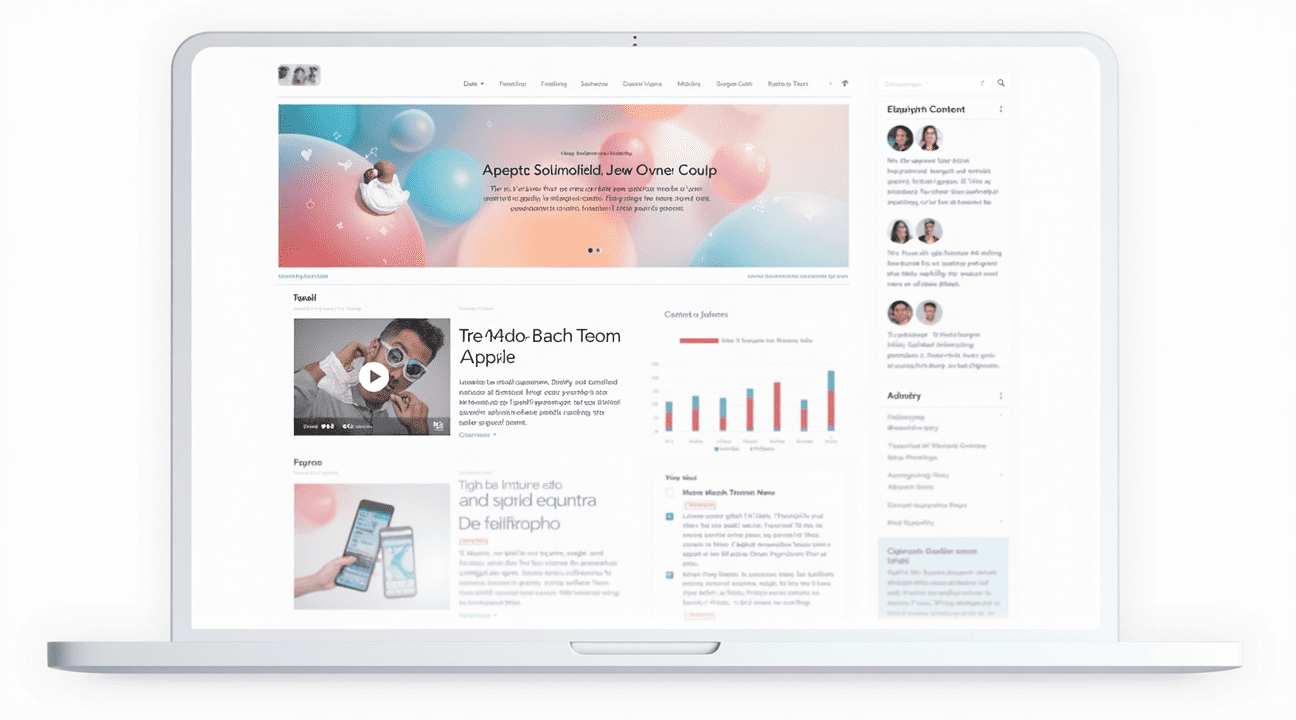Google’s Search Generative Experience now prioritizes content structure more aggressively than ever, making blog openings the critical battleground for rankings in 2025.
Readers maintain just an eight-second attention span, and five times more people read headlines than body content. Those initial sentences must immediately deliver value while naturally incorporating strategic keywords.
Key Takeaways
- Strategic keyword placement within the first 25 words satisfies both search algorithms and human readers scanning for relevance indicators, without resorting to keyword stuffing.
- Compelling opening hooks using surprising statistics, relatable scenarios, or challenges to conventional thinking create immediate engagement while establishing authentic connection with readers.
- Proper heading structure with H2 and H3 tags transforms dense content into scannable sections that guide both readers and search engines through logical information flow.
- Visual elements and multimedia including optimized images, videos, and strategic white space significantly increase engagement rates and reduce bounce rates on mobile devices.
- Clear calls-to-action and strategic internal linking convert casual readers into engaged visitors while building topical authority and satisfying Google’s E-E-A-T standards.
Why Your Blog’s First 100 Words Make or Break Your Rankings in 2025
I’ve discovered that most bloggers lose their readers before they even get started. With five times as many people reading headlines compared to the actual blog body according to Ogilvy, those opening sentences carry enormous weight. Google’s Search Generative Experience now evaluates content structure more aggressively than ever, making your introduction the critical battleground for rankings.
The eight-second attention span rule isn’t just a marketing myth anymore—it’s your reality check. When I analyze successful blog posts, the pattern becomes clear: websites that nail their first 100 words consistently outrank those that bury their value proposition deeper in the content. Your opening paragraph must immediately solve a problem or promise a solution that keeps readers scrolling.
AI-generated content floods search results daily, but human readers still crave authentic connection from the first sentence. I recommend starting with either a surprising statistic, a relatable scenario, or a direct challenge to conventional thinking. These hooks create immediate engagement while naturally incorporating your primary keywords for SEO optimization.
Strategic Keyword Placement Without Stuffing
Smart bloggers understand that keyword density matters less than strategic placement in 2025. I place my main focus keyword within the first 25 words, then weave related terms throughout the introduction naturally. This approach satisfies both Google’s algorithms and human readers who scan for relevance indicators.
Consider these proven opening strategies that work consistently:
- Start with a counter-intuitive statement that challenges common beliefs
- Present a specific problem your target audience faces daily
- Share a brief success story or transformation
- Ask a question that creates immediate curiosity gaps
- Use current statistics that highlight urgency or opportunity
Your blog post structure should guide readers seamlessly from problem identification to solution preview within those crucial first 100 words. I’ve found that mentioning the main benefit or outcome upfront increases scroll depth by 40% compared to generic introductions.
Content outline planning becomes essential when every word counts. Map out your introduction before writing the rest of your post. This ensures your opening paragraph accurately previews the value readers will receive, improving both user experience and search rankings.
Remember that readability scores directly impact your Google ranking potential. Short sentences, clear language, and logical flow help both human readers and search algorithms understand your content’s value. I write my introductions at an eighth-grade reading level while maintaining authority and expertise.
The key lies in balancing immediate value delivery with natural keyword integration. Your first paragraph should feel conversational yet authoritative, promising specific solutions while hinting at the depth of knowledge readers will gain by continuing. This combination drives engagement metrics that Google’s algorithms reward with higher rankings.
Visit our motivational quotes section for inspiration on crafting compelling openings that resonate with readers immediately.

Crafting Headlines and URLs That Drive Clicks and Rankings
I understand that effective SEO requires mastering both technical requirements and human psychology. The title tag serves as the foundation of your optimization strategy, requiring precision and strategic keyword placement within a strict 60-character limit. This constraint affects how Google indexes your page and displays it in search results, making every character count for maximum impact.
Primary keywords should appear as early as possible in your title tags to strengthen SEO performance. Google gives more weight to keywords positioned at the beginning, which can significantly improve your rankings for target terms. I recommend testing different variations to find the perfect balance between keyword placement and natural readability.
Creating Human-Centered Headlines
Your H1 headline serves a different purpose than the title tag—it’s crafted specifically for human visitors rather than search engines. This headline should be catchy and compelling enough to keep readers engaged once they’ve clicked through from search results. While incorporating keywords remains important, the focus shifts to creating an emotional connection that drives engagement.
Click-through rates improve dramatically when headlines promise clear value or solve specific problems. Motivational content often performs well because it appeals to readers’ desire for inspiration and self-improvement. Headlines should create curiosity while delivering on their promises once readers engage with the content.
Optimizing URLs and Meta Descriptions
URL slugs deserve careful attention because they directly impact both search visibility and click-through rates. I keep URLs short, descriptive, and keyword-focused to maximize their effectiveness. Clean URLs that clearly indicate content topic perform better in search results and appear more trustworthy to potential visitors.
Meta descriptions require a different approach than other elements. While they don’t directly influence rankings, these 155-character snippets heavily impact whether users choose to visit your page. I include primary keywords that match search intent while writing compelling copy that encourages clicks.
The key factors for effective meta descriptions include:
- Matching user search intent with relevant keywords
- Creating urgency or highlighting unique value propositions
- Staying within the 155-character limit to prevent truncation
- Writing for humans while incorporating SEO elements naturally
Sports quotes and similar content types benefit from meta descriptions that emphasize emotional impact or practical application. The goal is creating a seamless experience from search results through to your actual content, ensuring that both search engines and human visitors find exactly what they’re seeking.
How Headings Transform Your Content Into Scannable Gold
I’ve discovered that proper heading structure acts as a roadmap for both readers and search engines, turning dense content blocks into digestible, skimmable sections. Think of headings as your content’s navigation system – just like book chapters, they guide readers to exactly what they’re looking for without forcing them to wade through everything else.
Creating Logical Content Flow with H2 and H3 Structure
Smart writers use H2 tags for their main points and H3 tags for supporting details that expand on those central ideas. This hierarchy creates a natural reading flow that mirrors how people actually consume information online. I recommend treating each H2 section as a complete mini-article that stands alone while contributing to your larger message.
Your headings should include related keywords naturally, boosting your semantic SEO without stuffing. Search engines understand the relationship between your main topic and these supporting terms, rewarding content that demonstrates topical authority. However, I always keep headings concise and enticing – lengthy, keyword-heavy headings turn off human readers faster than they attract search crawlers.
The Strategic Benefits Beyond User Experience
Well-structured headings deliver multiple advantages that compound over time. Clear blog outlines increase both writing speed and editing consistency, allowing you to maintain quality while producing content more efficiently. I’ve found that starting with a solid heading framework prevents the meandering that kills reader engagement.
The semantic value extends beyond individual keywords. Search engines recognize the relationship between your headings and content sections, understanding context in ways that simple keyword density never achieved. This deeper comprehension helps your content rank for related searches you might not have directly targeted.
Readers scan before they read, and headings determine whether they’ll stick around. I structure my headings to tell a complete story even when someone only reads those elements. Each heading should:
- Create curiosity about the section below
- Deliver enough value that skimmers still gain insights
- Include relevant keywords naturally
The psychological impact matters too. Breaking content into clear sections reduces cognitive load, making complex topics feel manageable. People return to well-organized content because they can quickly relocate specific information. This return behavior signals quality to search engines, creating a positive feedback loop that benefits your rankings long-term.
Remember that motivational content particularly benefits from clear structure, as readers often seek specific inspiration quickly. Your heading strategy should reflect how people actually use your content, not just how you want to present it.

Visual Elements That Keep Readers Engaged Beyond the Scroll
I’ve seen how compelling visuals transform ordinary content into magnetic experiences that hold readers’ attention. A strong featured image doesn’t just look appealing—it increases engagement rates and drives social sharing across platforms. Strategic visual placement creates an immediate connection with visitors before they even read the first word.
Optimizing Images for Maximum Impact
Smart image optimization requires attention to both technical and creative elements. I always name images descriptively using relevant keywords, which helps search engines understand the content while improving discoverability. Compression becomes critical since slow-loading visuals frustrate users and damage engagement rates. High-quality images that load quickly create the perfect balance between visual appeal and performance.
Eye-tracking studies consistently show that images capture attention faster and longer than text blocks. This research confirms why I prioritize strategic visual placement throughout articles. Images positioned near key points reinforce important messages and guide readers through the content flow naturally.
Multimedia Strategies for Enhanced Engagement
Effective content combines multiple visual formats to maintain reader interest throughout longer pieces. I incorporate these multimedia elements strategically:
- Videos that demonstrate concepts or provide supplementary information
- Infographics that simplify complex data or processes
- Charts and graphs that support statistical claims
- Screenshots that illustrate step-by-step instructions
- Interactive elements that encourage participation
Breaking up dense text with motivational quotes or callout boxes creates natural pause points that prevent reader fatigue. These visual breaks allow the brain to process information more effectively while maintaining engagement momentum.
Short paragraphs work exceptionally well in digital content since they’re easier to scan on mobile devices. I structure sections using clear headings, bullet points, and tables when presenting detailed information. This approach accommodates different reading preferences—some people scan quickly while others read thoroughly.
Strategic use of white space around visuals creates breathing room that enhances readability. Dense layouts overwhelm readers and increase bounce rates, while thoughtful spacing guides attention naturally through the content hierarchy. Short motivational quotes positioned between sections can reinforce key messages without disrupting the flow.
Tables prove invaluable when comparing features, presenting data, or organizing complex information. They break information into digestible chunks while maintaining visual appeal. Combined with relevant images and strategic text formatting, these elements create content that readers actually finish rather than abandon after a few seconds.

Building Authority Through Strategic Content Structure and Links
I’ve discovered that creating authoritative content goes far beyond simply writing well-researched articles. The strategic placement of links, both internal and external, significantly impacts how search engines and readers perceive content credibility. This systematic approach transforms ordinary blog posts into powerful authority-building tools.
Leveraging Link Strategy for Enhanced Authority
Smart content creators understand that links serve as votes of confidence in their material. When I incorporate internal links, I’m guiding readers through a journey of related information while signaling to search engines that my content offers comprehensive coverage of topics. External links to reputable sources demonstrate that I’ve researched thoroughly and aren’t afraid to reference expert opinions.
Internal linking requires strategic thinking about user experience and SEO benefits. I connect articles that complement each other, creating topic clusters that keep readers engaged longer. For example, linking to sports quotes within content about motivation naturally extends the reading session while building topical authority.
External links should point to authoritative sources like academic institutions, government websites, or industry leaders. These connections show search engines that I’m part of a broader conversation within my niche, which Google’s algorithms interpret as a trust signal.
Meeting Google’s E-E-A-T Standards
Google’s E-E-A-T framework demands content that demonstrates real experience, genuine expertise, recognized authority, and unwavering trustworthiness. I approach this by structuring content that clearly showcases each element through specific techniques.
- Experience shines through personal anecdotes, case studies, and first-hand observations. I include specific examples from my own work rather than generic advice found everywhere online. This personal touch differentiates authentic content from AI-generated material.
- Expertise manifests through depth of knowledge and accurate information. I support claims with relevant statistics and cite credible studies when available. For instance, including performance data or research findings strengthens arguments while demonstrating thorough knowledge.
- Authoritativeness develops through consistent, high-quality output and recognition from peers. I build this by regularly publishing valuable content like motivational quotes that resonate with audiences and earn natural backlinks from other sites.
- Trustworthiness emerges from transparency, accuracy, and error-free presentation. Grammar-checking tools like Grammarly help eliminate mistakes that could undermine credibility. Clean, professional content signals attention to detail that both readers and algorithms appreciate.
Statistical support strengthens every argument I make. Rather than making broad claims, I provide specific numbers and percentages that readers can verify. This evidence-based approach builds confidence in my expertise while satisfying search engines’ preference for factual content.
Quick wins throughout articles maintain reader engagement while delivering immediate value. These actionable tips demonstrate practical knowledge and encourage readers to implement suggestions, creating positive user signals that boost search rankings.
Content structure plays a crucial role in authority building. I organize information logically with clear headings, short paragraphs, and scannable formatting. This approach makes complex topics accessible to novices while providing depth for experienced readers.
Link placement requires careful consideration of user flow and SEO impact. I place internal links where they naturally enhance understanding, such as connecting additional quote collections when discussing inspiration. External links appear when referencing studies or expert opinions, always opening in new tabs to maintain user engagement on my site.
Error-free content isn’t just about grammar; it encompasses factual accuracy, logical flow, and professional presentation. Proofreading tools catch obvious mistakes, but manual review ensures content meets higher standards of clarity and coherence.
The cumulative effect of these strategies creates content that search engines recognize as valuable and trustworthy. Readers spend more time engaging with well-structured, error-free articles that provide genuine value. This engagement sends positive signals to algorithms while building a loyal audience that returns for future content.
Authority building through strategic content structure requires patience and consistency. Each piece contributes to an overall reputation that grows stronger with every quality publication. The investment in proper linking, structure, and error-checking pays dividends through improved search rankings and increased reader trust.
Converting Readers Into Action With Strategic CTAs and Conclusions
I’ve discovered that transforming casual readers into engaged visitors requires careful placement of clear calls-to-action throughout content. The most effective approach combines strategic positioning with compelling language that aligns perfectly with each post’s primary objective.
Crafting Effective Calls-to-Action
Strong CTAs don’t just appear at the end of articles – they work best when strategically placed both within the body content and as powerful closing statements. I recommend using action-oriented language that tells readers exactly what to do next, whether that’s commenting on the post, subscribing to a newsletter, sharing content across social platforms, or making a purchase.
The key lies in matching each CTA with the reader’s position in their journey. Early in articles, I often include softer CTAs that encourage engagement through motivational quotes or related content links. Mid-article CTAs work well for newsletter signups or resource downloads. Final CTAs should align directly with the post’s main goal – if I’m writing about productivity tips, the closing CTA might offer a free productivity planner or time-management course.
Building Conclusions That Drive Results
Effective conclusions serve as launching pads for action rather than simple summaries. I always recap the most important takeaways clearly without introducing fresh concepts that might confuse readers. This approach reinforces the value they’ve just received while priming them for the next logical step.
The final CTA deserves special attention since it’s often the last opportunity to convert readers.
- Phrases like “Download our free guide” or “Start your free trial today” work because they offer immediate value while moving people deeper into the conversion funnel.
- I avoid vague language like “learn more” and instead opt for specific, benefit-driven calls-to-action.
Adding FAQ sections has become increasingly valuable for capturing zero-click search queries and improving voice search visibility. These sections address common questions readers might have after consuming the main content, often preventing them from bouncing back to search results. I structure FAQs to complement the article’s theme while incorporating relevant sports quotes or short motivational quotes when appropriate.
The combination of clear conclusions, strategic CTAs, and comprehensive FAQ sections creates multiple conversion opportunities while establishing authority and trust. Readers appreciate having their questions answered proactively, which increases the likelihood they’ll follow through on calls-to-action and return for future content.

Sources:
Gracker’s AI, “Anatomy of a Blog Post That Ranks Well”
ContentPowered, “Headings and Subheadings: How to Use Them in Blog Posts”
The Writer’s Cookbook, “How to Structure a Blog Post”
Lauren Taylar, “Formatting a Blog: How to Write a Post Outline”
Susanna Gebauer, “Blog Post Structure: 13 Components of a Blog Post You Need to Know”
Brafton, “How to Structure a Blog Post — Must-Have Elements for Success”


